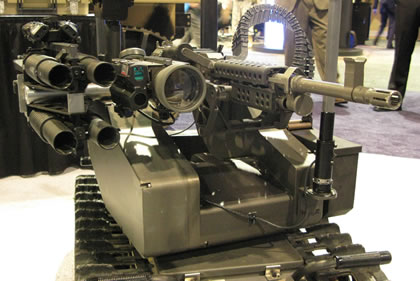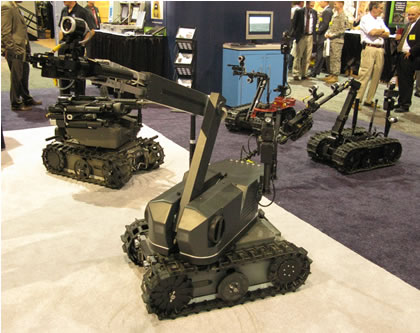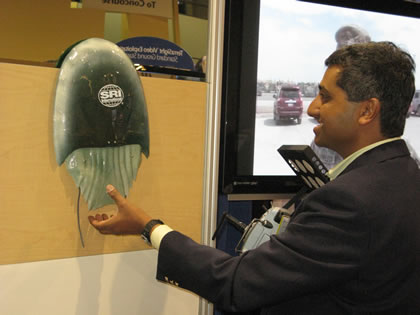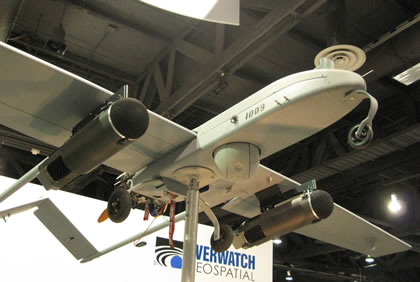Only few new robotic platforms were displayed at AUSA 2008, but much progress was reported and displayed with current programs, including the Army’s Future Combat Systems (Micro Aerial Vehicle Class I, Small Unmanned Ground Vehicle (SUGV), and autonomous guidance system, destined for integration in all FCS manned and unmanned vehicles to support autonomy and teleoperation.
A range of enhancements developed for the Dragon Runner was unveiled by QinetiQ, targeting future US Marine Corps requirements while iRobot introduced the SUGV 300 family, transforming the company’s current product line designed toward the future FCS SUGV. Much progress was made with the MULE, a larger member of the FCS robotic team. MULE is currently undergoing ground and mobility tests and is expected to enter operational evaluation with the FCS evaluation force by next year.
The new range of ‘Dragon Runner’ Small Unmanned Ground Vehicle (SUGV). was unveiled at AUSA 2008 by QinetiQ North America. These robots represent a modular ground robot system capable of performing a wide range of missions in urban, mountainous or rural environments, from underground and in-house to the handling of improvised explosive device (IEDs).
iRobot introduced the SUGV300 family of robots derived from the latest development of the Pacbot, earlier known as the ‘Future Combat Systems Small UGV (FCS-UGV). Actually, one of teh members of the new family, the SUGV320 is the robot designated for the future FCS mission (SUGV). Other versions are being produced for near term fielding, as part of the first ‘Spinout’ of the FS program. Among these are the SUGV300 designed as a basic reconnaissance lightweight robot and the SUGV310, designed for dismounted EOD missions. The ‘300 is the basic platform, without payloads, weighing only 25 lbs (11.3 kg). All the SUGV300 family robots fit into the soldier’s backpack (MOLLE) or ALICE packs, and are powered by standard BB-2590/U batteries for more than six hours of operation.
Another robotic component of the FCS to be utilized on all manned and unmanned vehicles, is the Autonomous Navigation System (ANS) developed by General Dynamics Robotics Systems. ANS is one of the basic components to be integrated in many Future Combat Systems autonomous and optionally autonomous driven vehicles. The system is currently being integrated and tested. During these tests the ANS team demonstrated that the system has matured enough to be ready for integration into tactical trucks and Stryker combat vehicles.
Another robotic member of the FCS family is the MULE, being developed by Lockheed Martin. The latest version of the ULE was on display at AUSA, demonstrating its new wheels, utilizing springs made of composite materials, instead of inflatable tires. These wheels are less vulnerable to small-arms and fragments hits, and can operate continuously without replacement or maintenance even after suffering severe damage or hits.
A near term alternative to the futuristic MULE was unveiled here by the name ‘Gideon’, by the Israeli company MDT. This armored version of a 6×6 Polaris ATV s modified by MDT Armor to provide a protected logistical support vehicle supporting forward elements. The vehicle cab is protected against small-arms up to 7.62 AP. The vehicle is suitable for carrying heavy or otherwise sensitive load (such as missiles, ammunition or sensitive electronic equipment. On the return trip the vehicle could be configured to carry two wounded soldiers on litters.
Among the new versions of the Pacbot 510, I-Robot displayed an application of the head-aimed remote viewer (HARV) developed by Chatten Associates. By duplicating the operator’s head motions this control mechanism increases the UGV operator’s performance by 300-400% demonstrated in tested conducted under DARA and the Army Research Labs studies. The system comprises of a visor embedded with an OLED display and an electronics and power unit. The system can utilize the vehicle’s existing communications link.
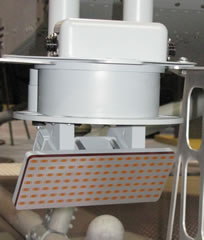 Northrop Grumman displayed the STARLite compact, synthetic aperture radar latest at AUSA 2008. (picture in right) The radar is destined for the Army’s Firescout Class IV UAV. Considered as a complimentary sensor to the U.S. Army Future Combat Systems program, STARLite features an electronically scanned array design providing an optimal balance of operational and cost effectiveness by blending electronic scanning with mechanical array positioning.
Northrop Grumman displayed the STARLite compact, synthetic aperture radar latest at AUSA 2008. (picture in right) The radar is destined for the Army’s Firescout Class IV UAV. Considered as a complimentary sensor to the U.S. Army Future Combat Systems program, STARLite features an electronically scanned array design providing an optimal balance of operational and cost effectiveness by blending electronic scanning with mechanical array positioning.
The new radar will provide precision ground mapping and indicate moving targets on surveillance and target acquisition missions. Sofar the program focused on the technical issues associated with transition to production, said U.S. Army Lt. Colonel Terrance Howard, product manager for the STARLite program. He confirmed that Northrop Grumman, the prime contractor successfully demonstrated the system during the source selection phase and that the program is on schedule to qualify the system by early 2009. The goal is to deliver 15 units to the warfighter by June 2009. In April 2008 Northrop Grumman was awarded a $47 development contract to manufacture these systems.
In many parts of the world, foliage is one of the most effective concealment resources available to military or terrorist forces. Thales is offering a solution to the problem of detecting and distinguishing threats hiding in a forested or jungle area or along forest paths, behind tree canopies. The Ground Alerter 1 non-line-of-sight UHF ground-based short range radar is designed to improve perimeter and border protection in densely forested terrains terrain. The radar uses a static portable antenna, mounted on a tripod, or a fixed, mast-mounted unit built on a roof. The radar continuously and automatically monitors the covered area, at ranges from 150 to 1,200 meters and will alert the operator of the presence of an intruder with minimal operator intervention and low false-alarm rate. The radar can be integrated with other sensors to complement existing security systems.
SRI’s wall-climbing robots scale vertical surfaces by virtue of electro-adhesion, which involves inducing electrostatic charges on a wall substrate. Since 2007 SRI developed several proof of principle robots, under a DARPA funded program.
Another new on display at AUSA 2008 was QuickMeds (picture below) – a precision delivery system designed for emergency situations where traditional supply methods might place additional soldiers at risk. Under the US Army Aviation & Missile Research, Development and Engineering Center (AMRDEC) Quick-MEDS program Dynetics is developing a multi-purpose GPS/INS based guided delivery system. The current design is sized for tactical UAS with 20 lbs total weight per pod (10 lbs payload). The QM payload is scalable and in phase 2 design is compatible with standard 14″ lug mechanisms for deployment from larger aircraft (both manned and unmanned). During the guided drops performed sofar Quick-MEDS successfully demonstrated effective guidance and control guiding the payload within 2 meters from its designated target and a total system error of less than 10 meters throughout the tests.
Other articles covering robotic systems at AUSA 2008 include:

